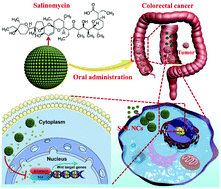Salinomycin nanocrystals for colorectal cancer treatment through inhibition of Wnt/β-catenin signaling†
Abstract
Salinomycin (SAL) is one of the first discovered inhibitors of human cancer stem cells (CSCs), which acts via blocking the Wnt/β-catenin pathway. However, SAL has not been clinically used to treat human diseases due to its poor aqueous solubility and considerable toxicity. In this study, we developed salinomycin nanocrystals (SAL NCs) to treat colorectal cancer through the inhibitory enhancement of Wnt/β-catenin signaling. The as-prepared SAL NCs exhibited excellent size distribution, stability, and improved water solubility. In vitro cellular uptake and in vivo fluorescence imaging studies showed that SAL NCs increased cellular uptake efficiency compared with free SAL. As a result, SAL NCs exhibited significant higher cytotoxicity, 1.5–3 times better Wnt inhibitory effect, and 10 times better cancer stem cell inhibitory effect than free SAL. Furthermore, compared with free SAL, SAL NCs exhibited 2 times better anti-colon tumor effect in APCmin/+ transgenic mice through oral administration. Our results indicated that SAL NCs with enhanced cellular internalization and tumor tissue accumulation may be a promising agent for colorectal cancer management.



 Please wait while we load your content...
Please wait while we load your content...